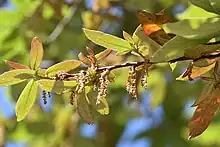| Quercus × dysophylla | |
|---|---|
 | |
| Scientific classification | |
| Kingdom: | Plantae |
| Clade: | Tracheophytes |
| Clade: | Angiosperms |
| Clade: | Eudicots |
| Clade: | Rosids |
| Order: | Fagales |
| Family: | Fagaceae |
| Genus: | Quercus |
| Subgenus: | Quercus subg. Quercus |
| Section: | Quercus sect. Lobatae |
| Species: | Q. × dysophylla |
| Binomial name | |
| Quercus × dysophylla | |
| Synonyms[1] | |
|
List
| |
Quercus × dysophylla is a species of oak tree. It grows in central Mexico in Hidalgo, México State, D.F., Puebla, Michoacán, and San Luis Potosí.[2][3] Its parents are Q. crassifolia and Q. crassipes,[1] both members of section Lobatae.[4]
It is a tree growing up to 20 metres (66 feet) tall. The leaves are thick and leathery, up to 17 centimetres (6+3⁄4 inches) long, elliptical with no teeth or lobes.[2]
References
- 1 2 "Quercus × dysophylla Benth". Plants of the World Online. Royal Botanic Gardens, Kew. Retrieved 2023-02-28.
- 1 2 Romero Rangel, S., E. C. Rojas Zenteno & M. L. Aguilar Enríquez. 2002. El género Quercus (Fagaceae) en el estado de México. Annals of the Missouri Botanical Garden 89(4): 551–593 in Spanish, with line drawings of each species
- ↑ McVaugh, R. 1974. Flora Novo-Galiciana: Fagaceae. Contributions from the University of Michigan Herbarium 12(1,3): 1–93
- ↑ Denk, Thomas; Grimm, Guido W.; Manos, Paul S.; Deng, Min & Hipp, Andrew L. (2017). "Appendix 2.1: An updated infrageneric classification of the oaks" (xls). figshare. Retrieved 2023-02-24.
External links
This article is issued from Wikipedia. The text is licensed under Creative Commons - Attribution - Sharealike. Additional terms may apply for the media files.